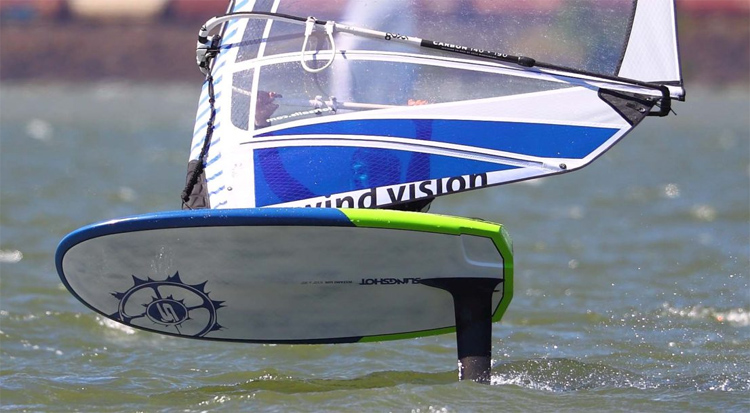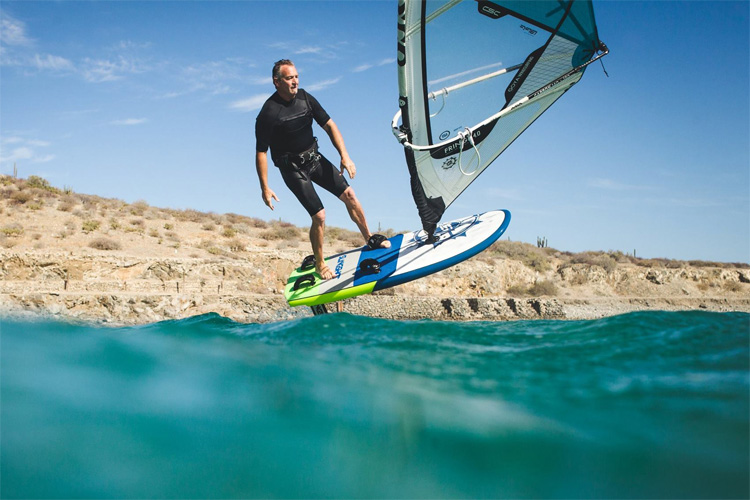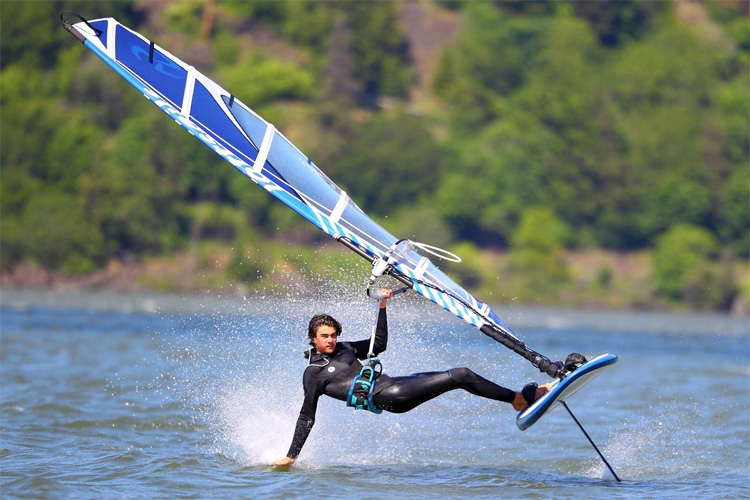Foil windsurfing is an exciting and unique new discipline. Learn to get flying effortlessly above water.
Windsurf foiling will allow you to experience a silent flight above the water. Hydrofoils offer a different sensation and will make your bigger board feel looser and freer.
One of the greatest advantages of foiling is that you'll be able to sail a windsurfer in really light winds. This underwater wing will allow you to ride according to your personal style.
If you're an intermediate rider, your leap into foils will be relatively easy, but if you've never windsurfed before, you'll only need a few extra hours to get used to the equipment.
Foils are very sensitive to weight transfers, demand a good pumping technique, and can be tricky to control. But they also make everything accessible and rideable.
Slingshot launched the Windsurf Foil Academy, an online foil windsurfing course led by Tony Logosz that will help you glide above water through a series of 10 fundamental stages.
Here's a quick summary of what you should do to become an accomplished windsurf foil master:
First Experiences
To get things started, use a shorter and more manageable mast - for example, a 15-inch mast. It will make the learning process easier and safer.
When you're comfortable and riding short distances using the foil - and the adaptation can last anything between 15 minutes to 15 hours - try a 24-inch setup.
Are you already gliding smoothly and silently over the water? Are you getting extended and controlled rides without touching down? It's time to move to the 30-inch mast.
Remember that, ideally, you should up-haul about 90 percent of the time. But if you really want to water start, make sure you wear booties.
Windsurf Foil Equipment
Try to maintain a distance of 43" from your Tuttle box front screw to the center of your mast step, and then adjust a few inches back and forth to suit your preference.
Remember that the more you move the wing forward, the more front foot pressure you will need to apply.
If you move your foot straps back, it will generate more lift, and you'll need less front foot pressure. Moving them forward allows for higher speeds, more aggressive riding, and on-foil transitions.

Back Foot and Front Foot Pressure
The way you're standing on the board will have an impact on its behavior.
In the first foiling experience, ride with your back foot in the back foot strap position. You'll notice that it is similar to how windsurfing already feels, and it's the easiest stage to prevent over-foiling.
At Stage 1, it's relatively easy to control high speeds. You'll be sailing on your heels more than your toes, and a lot of pressure will be on your harness rather than on your arms.
The moment you can foil comfortably with your back foot in front of the foot strap, you're ready for Stage 2.
Once you can stay on the foil the whole time, you're ready to fly longer, ride faster, and start jibing. That's Stage 3.
Pull your back foot out, place it in front of the strap, and make fine adjustments to your body position while still maintaining a comfortable flight.
Try to balance foot straps, mast step placement, harness line, board, and foil.
Now that you're planing smoothly above water with your weight over your front foot, you're ready for a more aggressive attitude.
Railing hard upwind, edging, jumping, ripping turns, and railing 360s in constant motion are some of the possibilities that are now open.
Jibing While Foiling
Jibes a wind foil can be hard and frustrating, so you have to train and have patience until your brain and your body acquire the muscle memory necessary for making essential turns.
Concentrate on your back foot. Get it over the center line of the board, and try to maintain a full radius jibe. Keep the pressure on and carve the board. The sail will respond accordingly.
Then, it's time to switch your feet and complete the turn while keeping the board well above water.

Safety Tips
The learning process can be intimidating and challenging and requires experience, confidence, and proficient windsurfing skills.
Foiling requires acute attention to body position, posture, and weight distribution. Learning these skills requires developing new muscle memory before they feel natural.
That's why you should master planing, jibing, the waterstart, uphauling, upwind, and downwind sailing before you begin foiling.
Moreover, when learning, try to find flat water and relatively light wind speeds of around 15-20 knots. You also now have to take the water depth a bit more seriously than you are used to.
We recommend learning in a place with long stretches of water between four and five feet deep. Ideally, the spot would have water that drops off quickly to make managing your foil rig a little easier on you.
Finally, wear a helmet, impact vest, and a full wetsuit before hitting the water.
Mastering the Ride
As you progress and begin to understand how foils work and how to balance your center of gravity, you'll start to master the art of shooting upwind, figuring out how to make it back downwind, and controlling your front-to-back foot pressure ratio.
At some point, crashing and wiping out will be inevitable. But you'll be hooked on foiling for the rest of your life.
